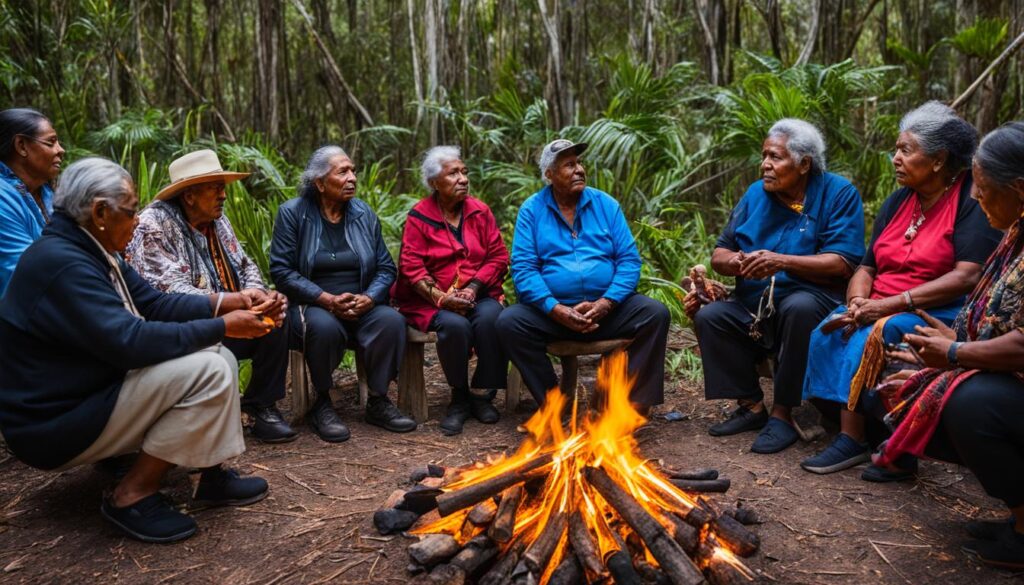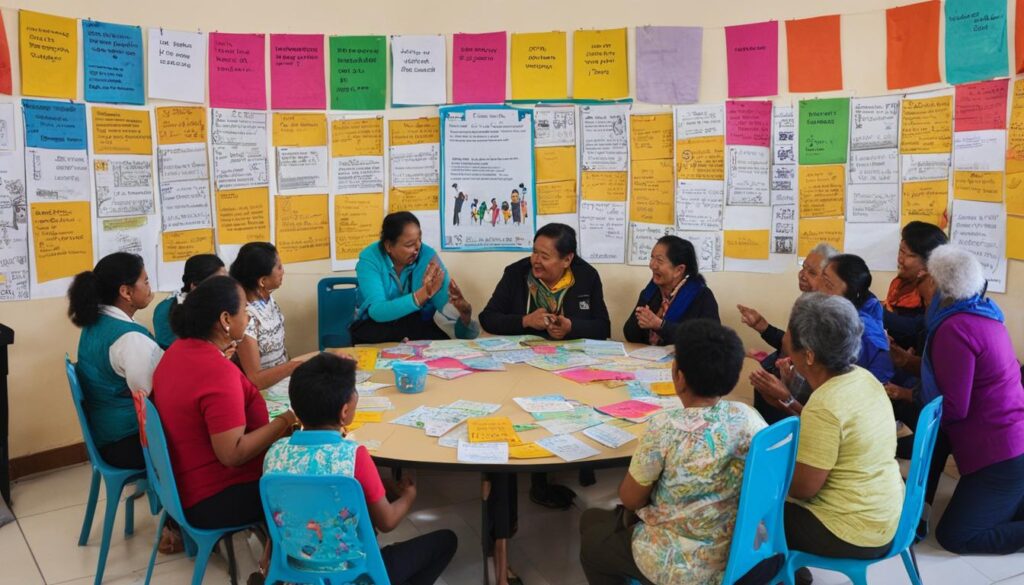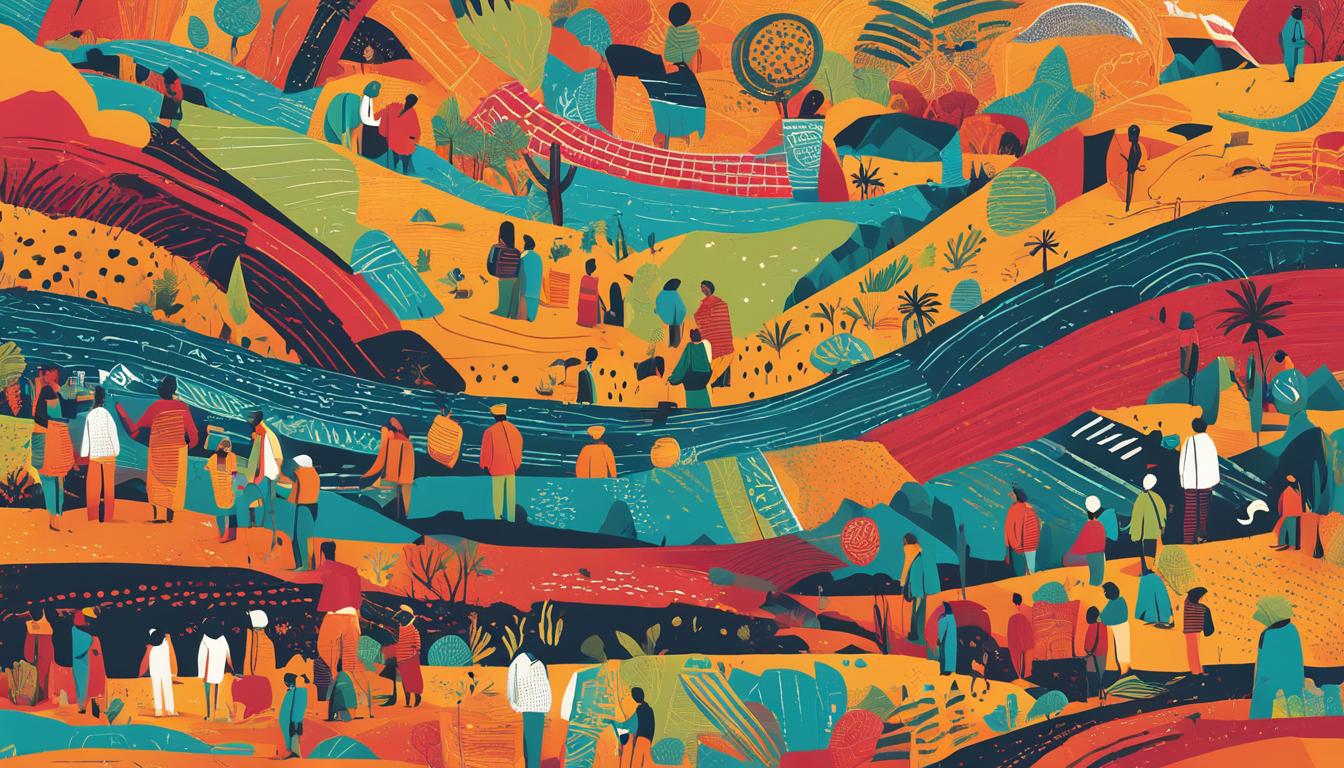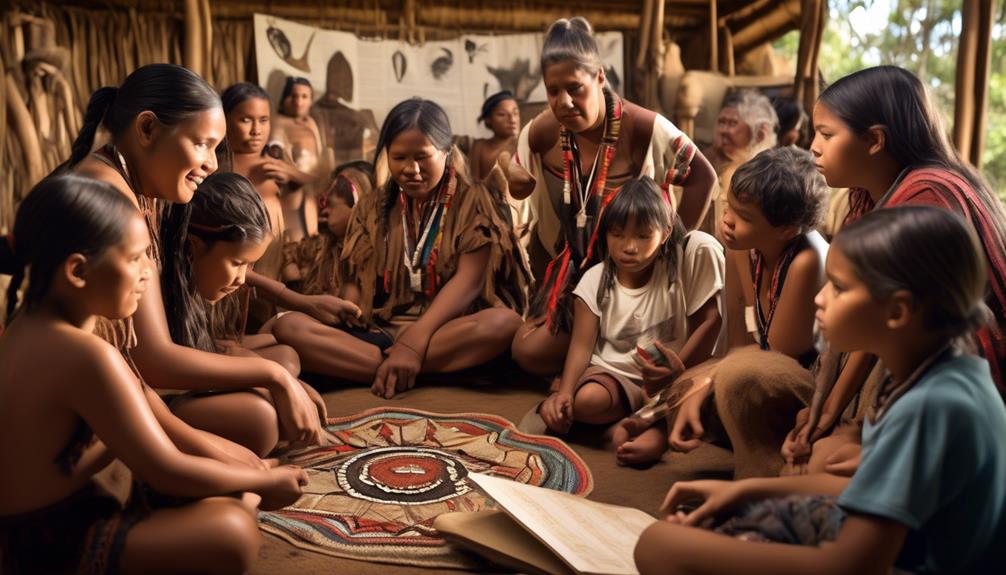In our ever more connected world, the preservation of linguistic diversity is more important than ever before, with many cultures and languages facing the risk of disappearing. Areas known as language hotspots, which are characterized by their diverse languages and presence of endangered languages, are in urgent need of revitalization efforts. At [Brand Name], we support the power of language in shaping personal identities, preserving cultural heritage, and improving social and emotional well-being. We welcome you to join us in recognizing the significance of revitalizing language hotspots and their crucial role in safeguarding linguistic diversity and endangered languages.
Key Takeaways:
- Language hotspots are areas with high linguistic diversity and endangered languages.
- The preservation of linguistic diversity is crucial to safeguarding cultural heritage.
- Language revitalization programs aim to document and revitalize endangered languages.
- Reviving language hotspots has positive impacts on mental health and social and emotional wellbeing.
- Preserving linguistic diversity is a collective responsibility that requires ongoing commitment and support.
The Linguists: Documenting Endangered Languages
In the documentary film “The Linguists” by Ironbound Films, linguists David Harrison and Gregory Anderson embark on a remarkable journey to language hotspots around the world. Their mission? To document endangered languages, also known as living tongues, before they disappear completely.
The Linguists offers a poignant insight into the threats faced by these languages, including institutionalized racism and economic unrest. The film sheds light on the significance of language preservation as a means of safeguarding cultures, histories, traditions, and unique knowledge systems that are embedded within these endangered languages.
“The Linguists” showcases the indispensable role of language preservation efforts in revitalizing endangered languages and promoting linguistic diversity.
Through their travels and firsthand experiences, Harrison and Anderson demonstrate how language documentation is not only a scholarly pursuit but also a vital endeavor for the preservation of our global linguistic heritage. They inspire viewers to recognize the importance of language diversity and the urgency of language revitalization initiatives.
Preserving Cultures and Traditions
The Linguists underscores that language is more than just a means of communication. It serves as a vessel for preserving cultures, traditions, and histories that are woven into the fabric of linguistic diversity. Languages carry the essence of a community’s identity, capturing its unique worldview and providing a sense of belonging to its speakers.
“The Linguists” reminds us that when a language is lost, an entire world of cultural expression and invaluable knowledge disappears with it.
The Search for Solutions
To address the decline of endangered languages, innovative solutions are required. The Linguists highlights the urgent need for language preservation programs, initiatives, and collaborations. These efforts aim to document endangered languages, support revitalization initiatives, and empower linguistic minority communities to reclaim and revitalize their languages.
By embracing a collaborative approach that involves linguists, community members, educators, and policymakers, we can work towards sustaining linguistic diversity and promoting the vitality of endangered languages.
Implications for Linguistic Diversity
The Linguists serves as a wake-up call, urging us to recognize the far-reaching implications of the gradual loss of linguistic diversity. As each language disappears, we lose not only a unique linguistic system but also the invaluable insights that it provides into human cognition, cultural practices, and social dynamics.
To truly celebrate and embrace linguistic diversity, we must actively engage in language documentation, preservation, and revitalization efforts. Only through these collective endeavors can we ensure a vibrant and inclusive linguistic landscape for future generations.
| Key Takeaways from “The Linguists” | |
|---|---|
| Language preservation is crucial for safeguarding cultures, histories, traditions, and unique knowledge systems. | 💡 |
| Endangered languages face threats such as institutionalized racism and economic unrest. | 💡 |
| Collaborative efforts between linguists, communities, educators, and policymakers are essential for language revitalization. | 💡 |
| The loss of linguistic diversity has far-reaching implications for our understanding of human cognition, cultural practices, and social dynamics. | 💡 |
The Impact of Language Reclamation on Mental Health and Wellbeing
Language reclamation, the process of revitalizing and reclaiming endangered languages, has a profound impact on mental health and social and emotional wellbeing. It goes beyond increasing the number of language speakers; it is about strengthening cultural renewal, building cultural identity, and improving overall wellbeing within linguistic minority communities.
The Power of Language in Building Linguistic Identity and Connection
Studies have shown that language reclamation activities foster a deep sense of connection among Indigenous peoples. Reconnecting with their ancestral language helps individuals establish a strong linguistic identity rooted in their cultural heritage. By reclaiming their endangered languages, they establish a connection not only to their spirituality, culture, and community but also to their own sense of self.
“Language is at the core of our cultural identity. When we reclaim our indigenous languages, we rediscover parts of ourselves that were lost. It gives us a sense of belonging and pride in our heritage.”
The Role of Language Reclamation in Mental Health and Wellbeing
The impact of language reclamation on mental health and wellbeing is substantial. Reconnecting with one’s language has been linked to reduced levels of stress, anxiety, and depression among linguistic minority communities. It provides a strong support system, fosters a sense of belonging, and enhances overall social and emotional wellbeing.
Language reclamation activities help combat the negative effects of colonization, marginalization, and cultural assimilation. They offer a space for individuals to heal from historical trauma and regain a sense of pride in their cultural heritage.
Language Reclamation as a Path to Cultural Renewal
By reclaiming endangered languages, communities embark on a journey of cultural renewal. Language revitalization efforts instill a strong sense of cultural pride and identity in current and future generations. The transmission of ancestral knowledge, traditions, and values becomes possible, ensuring that the cultural fabric of linguistic minority communities remains intact.
Language reclamation serves as a platform for strengthening community bonds and intergenerational connections. It creates opportunities for shared experiences, intercultural dialogue, and the passing down of traditions from elders to younger community members.
The Holistic Benefits of Language Reclamation
Language reclamation has far-reaching benefits beyond individual and community wellbeing. It contributes to the preservation of linguistic diversity, enriching the global cultural tapestry. The revitalization of endangered languages allows for the exchange of knowledge, ideas, and perspectives that might otherwise be lost.
Furthermore, the mental health and wellbeing outcomes associated with language reclamation ripple beyond linguistic minority communities. Society as a whole benefits from the preservation of cultural heritage, increased intercultural understanding, and the celebration of linguistic diversity.
Language reclamation is a transformative journey, promoting mental health, social and emotional wellbeing, and cultural renewal. The power of language in fostering connection, identity, and community cannot be overlooked. By investing in language reclamation, we create a more inclusive and vibrant society for all.
Indigenous Language Revitalization in Australia
Indigenous languages in Australia have endured significant challenges stemming from colonization and the erasure of languages. However, a growing desire among Indigenous communities to reclaim and revitalize their traditional languages has emerged. Language revitalization projects in Australia, such as the Barngarla Language and Wellbeing Study, are leading efforts to assess the impact of language reclamation on mental health and social and emotional wellbeing. These projects recognize the pivotal role that language plays in cultural renewal, identity formation, and overall community wellbeing within Indigenous communities.
By restoring Indigenous languages, these revitalization projects aim to reconnect individuals with their cultural heritage and reclaim their linguistic autonomy. The preservation and revitalization of Indigenous languages are essential for ensuring the transmission of cultural knowledge, fostering a sense of belonging, and promoting overall social and emotional wellbeing.
The Barngarla Language and Wellbeing Study
“Language is the key to cultural renewal and the revitalization of the spirit of our people.”
The Barngarla Language and Wellbeing Study is an exemplary initiative focused on evaluating the effects of language reclamation on mental health and social and emotional wellbeing among the Barngarla people in South Australia. Led by a team of linguists, community leaders, and health professionals, the study recognizes the intrinsic connection between language and overall wellbeing.
Through an extensive research framework, the Barngarla Language and Wellbeing Study comprehensively examines the benefits of language revitalization for the Barngarla people. By collecting data and engaging with community members, this project aims to demonstrate the positive effects of language reclamation on mental health, cultural renewal, and identity formation.
The Impact of Language Revitalization on Communities
The revitalization of Indigenous languages holds considerable promise for the cultural and social revitalization of Indigenous communities in Australia. Language forms the bedrock of cultural expression, reinforcing a sense of cultural identity and facilitating intergenerational transfer of knowledge. By revitalizing Indigenous languages, communities can restore their histories, preserve their cultural traditions, and strengthen community connections.
Furthermore, language revitalization projects contribute to the social and emotional wellbeing of Indigenous communities. By reclaiming their languages, individuals can experience a renewed sense of pride, belonging, and self-esteem. Language revitalization provides a vital tool for individuals to express their cultural heritage, fostering a sense of empowerment and contributing to improved mental health outcomes.
Language revitalization projects in Australia represent a transformative initiative aimed at reclaiming and preserving Indigenous languages. These projects recognize the immense value of language in cultural renewal, promoting social and emotional wellbeing, and safeguarding linguistic diversity. By investing in language revitalization efforts, we empower Indigenous communities and forge a path toward a culturally rich and inclusive future.
The Importance of Language Preservation in Indigenous Communities
Language preservation is a fundamental aspect of Indigenous culture, directly tied to cultural expression, autonomy, and the spiritual and intellectual sovereignty of Indigenous peoples. It is our inherent right to revitalize, use, develop, and pass down our languages to future generations. Unfortunately, the loss of Indigenous languages, a consequence of colonization, has had detrimental effects on the mental health and overall wellbeing of Aboriginal and Torres Strait Islander populations.
In Indigenous communities, language is more than just a means of communication. It is a powerful tool for cultural expression, enabling us to express complex ideas, traditions, stories, and our unique ways of knowing and understanding the world around us. By preserving our languages, we preserve our cultural heritage and ensure the continuity of our diverse linguistic traditions, strengthening our sense of identity and connection to our ancestors.

Language preservation efforts are vital for the wellbeing of Indigenous communities, as language is deeply intertwined with our social, emotional, and spiritual health. When Indigenous languages are diminished or lost, there is a significant impact on our sense of belonging, self-esteem, and community cohesion. Research has shown that a strong connection to language is associated with improved mental health outcomes, higher educational achievement, and increased cultural pride among Indigenous individuals.
“Language is like the air we breathe – it is vital for our existence, and without it, we wither and die. Language is the core of our identity, culture, and wellbeing.”
Language preservation programs and initiatives are essential in ensuring the ongoing restoration and revitalization of Indigenous languages. These efforts empower Indigenous communities to reclaim their linguistic autonomy, strengthening cultural identity and self-determination. Through the revitalization of our languages, we transmit traditional knowledge, stories, and values to future generations, fostering a sense of pride and belonging.
The Impact of Linguistic Autonomy on Health and Wellbeing
Linguistic autonomy plays a crucial role in promoting the health and wellbeing of Aboriginal and Torres Strait Islander peoples. When communities have control over their languages and can freely express themselves in their mother tongue, it helps to address the historical trauma and injustices inflicted upon Indigenous populations. By reclaiming and revitalizing our languages, we empower ourselves and future generations, improving our overall quality of life and fostering cultural resilience.
Research has highlighted the significant positive effects of language preservation on mental health outcomes, social connectedness, educational attainment, and the preservation of cultural heritage. Indigenous communities that have succeeded in revitalizing their languages have experienced increased community cohesion, reduced rates of substance abuse, and improved emotional well-being.
Furthermore, language preservation serves as a form of resistance against ongoing language loss and erosion of Indigenous cultures. It promotes cultural diversity, fostering intergenerational transmission and creating pathways for our unique knowledge systems, traditions, and perspectives to thrive.
| Benefits of Language Preservation in Indigenous Communities |
|---|
| Promotes cultural expression and identity |
| Strengthens community connection and cohesion |
| Improves mental health and emotional well-being |
| Reduces rates of substance abuse |
| Enhances educational attainment |
| Preserves traditional knowledge and wisdom |
Language Revitalization Strategies and Techniques
Language revitalization involves a range of strategies and techniques aimed at reclaiming and revitalizing endangered languages. These efforts are crucial in conserving linguistic diversity and preserving cultural heritage. By implementing various tactics, we can ensure the survival and revival of languages that are on the brink of extinction.
The Importance of Language Documentation
Language documentation plays a vital role in capturing and preserving endangered languages. Linguists and language enthusiasts work diligently to record and analyze linguistic data, including vocabulary, grammar, and pronunciation. These valuable resources not only serve as references for future generations but also provide insights into the rich cultural traditions and knowledge systems associated with each language.
Language Classes and Immersion Programs
Language classes and immersion programs are essential for promoting language revitalization. These initiatives create opportunities for individuals to learn and engage with endangered languages in immersive environments. By offering interactive lessons, cultural activities, and real-life language usage, learners can develop their language skills while also fostering a deeper connection to their cultural heritage.
Community Engagement and Support
Community engagement and support are integral to the success of language revitalization efforts. By involving the linguistic minority communities in decision-making processes, programs can be tailored to meet their specific needs and aspirations. Local participation encourages a sense of ownership, pride, and motivation among community members, fostering long-term commitment to language conservation.
Development of Language Materials and Resources
Creating language materials and resources is crucial for language revitalization. These include textbooks, dictionaries, audio recordings, and digital platforms that facilitate language learning and usage. By providing accessible and culturally relevant materials, individuals can easily access and engage with endangered languages, supporting their acquisition and revitalization.
We believe that by implementing these revitalization strategies and techniques, we can both conserve endangered languages and ignite a sense of cultural pride and identity within linguistic minority communities.
Through language revitalization, we contribute to the preservation of linguistic diversity, ensuring that future generations have the opportunity to connect with their cultural heritage. Language revitalization is not just about words and grammar; it is about cultural resilience and honoring the rich tapestry of human expression. Join us in our efforts to revitalize endangered languages and foster cultural pride worldwide.
The Role of Education in Language Revitalization
Education plays a vital role in preserving and revitalizing endangered languages within linguistic minority communities. Language revitalization programs are crucial in ensuring that these languages are preserved and passed down to future generations. By integrating endangered languages into school curricula, language preservation in classrooms becomes a reality, allowing students to learn their heritage languages while promoting linguistic diversity.
One effective approach is heritage language education programs. These programs focus on teaching young learners their ancestral languages, fostering a sense of cultural identity and connection to their linguistic roots. By providing opportunities for students to learn and use their heritage languages, these programs contribute to the preservation and revitalization of endangered languages.
“Language is the road map of a culture. It tells you where its people come from and where they are going.” – Rita Mae Brown
Integrating endangered languages into educational settings goes beyond language skills acquisition. It plays a fundamental role in preserving linguistic heritage, promoting language continuity, and ensuring the cultural richness of linguistic minority communities. By providing language education opportunities, we empower communities to reclaim their languages, preserve their cultural heritage, and foster a deeper understanding and appreciation for linguistic diversity.
The Benefits of Language Revitalization in Education
Language revitalization in education brings about numerous benefits for both individuals and communities:
- Cultural preservation: Language revitalization in schools helps preserve the cultural traditions, values, and knowledge systems embedded within endangered languages.
- Linguistic diversity: By embracing endangered languages as part of the curriculum, schools contribute to the promotion of linguistic diversity, enriching the overall language landscape.
- Community connection: Language revitalization efforts in education foster a sense of community connection and pride, strengthening the social fabric within linguistic minority communities.
- Cognitive development: Learning multiple languages enhances cognitive abilities, including problem-solving skills, creativity, and critical thinking.
- Identity reinforcement: Language revitalization programs help individuals develop a strong sense of cultural identity, boosting self-esteem and resilience.
By prioritizing language revitalization in educational systems, we pave the way for the preservation of endangered languages and the rebuilding of diverse linguistic communities.

| Language Revitalization in Education | Effects |
|---|---|
| Promotes cultural preservation and heritage | Preserves endangered languages, traditions, and knowledge systems |
| Strengthens linguistic diversity | Enriches language landscape and promotes intercultural understanding |
| Fosters community connection | Builds social cohesion within linguistic minority communities |
| Enhances cognitive development | Improves problem-solving skills, creativity, and critical thinking |
| Reinforces individual and cultural identity | Boosts self-esteem, resilience, and cultural pride |
The Power of Language in Cultural Renewal
Language is an essential element of culture and plays a crucial role in cultural renewal. Revitalizing endangered languages strengthens cultural identity, fosters a sense of community connection, and ensures the transmission of traditions, values, and social identity.
By preserving and revitalizing languages, communities can reclaim their cultural heritage, strengthen their unique identities, and create a foundation for cultural renewal. Language revitalization efforts are vital in safeguarding linguistic diversity and promoting the rich tapestry of human cultures.
“Language is the road map of a culture. It tells you where its people come from and where they are going.” – Rita Mae Brown
When a language is lost, valuable cultural knowledge and practices are at risk of disappearing. Revitalizing endangered languages allows communities to preserve their traditional knowledge systems, oral histories, storytelling traditions, and indigenous cultural practices.
The revitalization of languages also serves as an important tool for intergenerational transmission of cultural values and practices. As younger generations learn their ancestral languages, they gain a deeper understanding of their roots and develop a stronger connection to their cultural heritage.
Language revitalization efforts often involve collaborative initiatives between community members, linguists, educators, and cultural institutions. These initiatives include language classes, immersion programs, and intergenerational language exchanges. They also focus on the development of language materials, resources, and technologies that support language learning and preservation.
The impact of language revitalization extends beyond individual communities. It contributes to the overall preservation of linguistic diversity, which is essential for the global community. Linguistic diversity enriches the world by promoting cross-cultural understanding, fostering intercultural dialogue, and preserving diverse ways of knowing and expressing ourselves.
By revitalizing endangered languages, we are not only preserving cultural heritage but also creating opportunities for cultural renewal, social cohesion, and a deeper appreciation of our collective human experience.
| Effects | Description |
|---|---|
| Cultural Identity | Revitalized languages strengthen cultural identity and foster a sense of belonging within linguistic minority communities. |
| Community Connection | Revitalizing languages brings communities together, fostering social cohesion, and promoting intergenerational connections. |
| Traditions and Knowledge Preservation | Language revitalization ensures the transmission of cultural traditions, knowledge systems, and ancestral practices. |
| Cultural Renewal | Preserving and revitalizing languages paves the way for cultural renewal, revitalization, and the reclamation of cultural heritage. |
The Future of Language Hotspots Revitalization
We are at a critical juncture when it comes to the revitalization of language hotspots and the preservation of endangered languages. The linguistic diversity that exists in these hotspots is in grave danger, with many languages facing the risk of extinction. However, the future of these languages lies in our hands, and it is essential that we take action now to ensure their survival for future generations.
Language revitalization efforts are pivotal in safeguarding the endangered languages found in these hotspots. By investing in language preservation programs, initiatives, and research, we can work towards revitalizing and preserving these languages that hold deep cultural significance. It is not just about the languages themselves; it is about preserving the cultural heritage and the richness of human expression that they embody.
Preserving linguistic diversity is not only important for the current linguistic minority communities but also for future generations. The knowledge, traditions, and values embedded in these languages are vital for the holistic development of societies. Revitalizing endangered languages ensures the transmission of unique cultural insights and promotes a broader understanding of the world we live in.
Language hotspots revitalization is a collective responsibility that requires ongoing commitment and support. Governments, organizations, linguists, and communities must work together to preserve linguistic diversity and revitalize endangered languages. By doing so, we can create a future where all languages, including those in hotspots, thrive and continue to contribute to our shared human heritage.
The Impact on Future Generations
Investing in language revitalization today will have a profound impact on future generations. When we revitalize endangered languages and ensure their survival, we provide future generations with a strong connection to their cultural roots. By preserving linguistic diversity, we give them the tools to understand and appreciate the richness of human expression and the importance of cultural heritage.
Furthermore, language revitalization efforts contribute to the overall well-being of future generations. Research has shown that bilingualism and multilingualism have cognitive, academic, and social benefits. By revitalizing endangered languages and promoting linguistic diversity, we create opportunities for future generations to develop a broader perspective, enhance their cognitive abilities, and foster empathy and understanding for different cultures.
The Role of Education
Education plays a crucial role in the revitalization and preservation of endangered languages. Incorporating endangered languages into school curricula and implementing heritage language education programs can ensure the continuation of these languages among younger generations. By learning their ancestral languages, future generations can build a stronger cultural identity and contribute to the preservation of linguistic diversity.
Language revitalization efforts create a brighter future for endangered languages and ensure the transmission of unique knowledge, traditions, and values to future generations.
Through education, we empower future generations to become language advocates, nurturing a sense of pride and responsibility towards their heritage languages. With the support of educational institutions, linguistic minority communities can pass down their languages to future generations and create a sustainable path for language hotspots revitalization.
The future of language hotspots revitalization is hopeful but requires ongoing commitment from all stakeholders. By investing in language revitalization efforts, we can pave the way for a future where linguistic diversity thrives, and the invaluable treasures of endangered languages continue to enrich our global cultural tapestry.
Conclusion
Reviving language hotspots is not only a force for good but also a necessity in preserving linguistic diversity and cultural heritage. Language revitalization efforts have a profound impact on the mental health, social and emotional wellbeing, and overall cultural renewal of linguistic minority communities.
By investing in language revitalization programs and initiatives, we create a brighter future for endangered languages and ensure the transmission of unique knowledge, traditions, and values to future generations. Our collective efforts to revitalize language hotspots contribute to the preservation of linguistic diversity and the enrichment of human expression.
Join us in our commitment to safeguard linguistic diversity and revitalize language hotspots. Together, we can make a difference by preserving languages, empowering communities, and celebrating the richness of our global linguistic heritage.
FAQ
What is language revitalization?
Language revitalization refers to the process of reclaiming and revitalizing endangered languages. It involves various strategies and techniques aimed at preserving and promoting linguistic diversity.
Why is language preservation important?
Language preservation is crucial for safeguarding cultural heritage, promoting cultural renewal, and preserving the unique knowledge, traditions, and values associated with endangered languages.
How do language revitalization programs work?
Language revitalization programs employ a range of strategies, such as language documentation, immersion programs, community engagement, and the development of language materials and resources, to revitalize endangered languages and strengthen linguistic minority communities.
What role does education play in language revitalization?
Education plays a vital role in language revitalization by integrating endangered languages into school curricula and promoting heritage language education programs. This helps preserve and revitalize languages within linguistic minority communities.
Can language reclamation improve mental health and wellbeing?
Yes, studies have shown that language reclamation activities can have positive impacts on mental health and social and emotional wellbeing, fostering a sense of connection to spirituality, culture, community, and identity among Indigenous peoples.
Are there any language revitalization projects in Australia?
Yes, Australia has ongoing language revitalization projects, such as the Barngarla Language and Wellbeing Study, that aim to assess the impacts of language reclamation on mental health and social and emotional wellbeing in Indigenous communities.
How does language revitalization contribute to cultural renewal?
Revitalizing endangered languages strengthens cultural identity, fosters a sense of community connection, and ensures the transmission of traditions, values, and social identity. It plays a vital role in cultural renewal within linguistic minority communities.
Why is linguistic diversity important?
Linguistic diversity enriches human cultures, promotes cross-cultural understanding, and preserves the vast array of human expression. Language revitalization efforts contribute to the conservation of linguistic diversity and the richness of human cultures.
What does the future of language hotspots revitalization depend on?
The future of language hotspots revitalization relies on continued efforts to preserve and revitalize endangered languages. It requires ongoing commitment and support to safeguard linguistic diversity and promote the preservation of cultural heritage.
How can I support language revitalization efforts?
You can support language revitalization efforts by raising awareness, advocating for the importance of linguistic diversity, and supporting organizations and initiatives that focus on language preservation and revitalization.
Talise is a talented writer and an expert in her field. Her unique perspective and insights enrich our content with depth and authenticity. With a wealth of knowledge and a strong connection to the subjects she writes about, Talise crafts engaging and informative articles that resonate with our readers. Her dedication to bringing Indigenous culture and wisdom to light is truly commendable.










